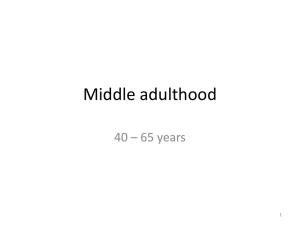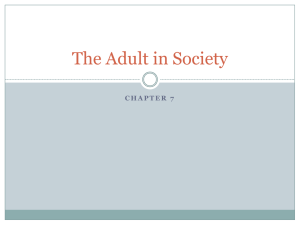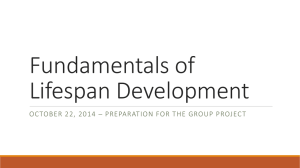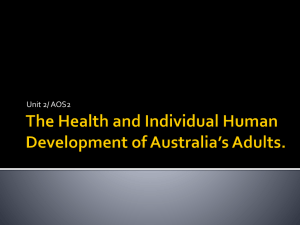FELDMAN DAL 7th_C15
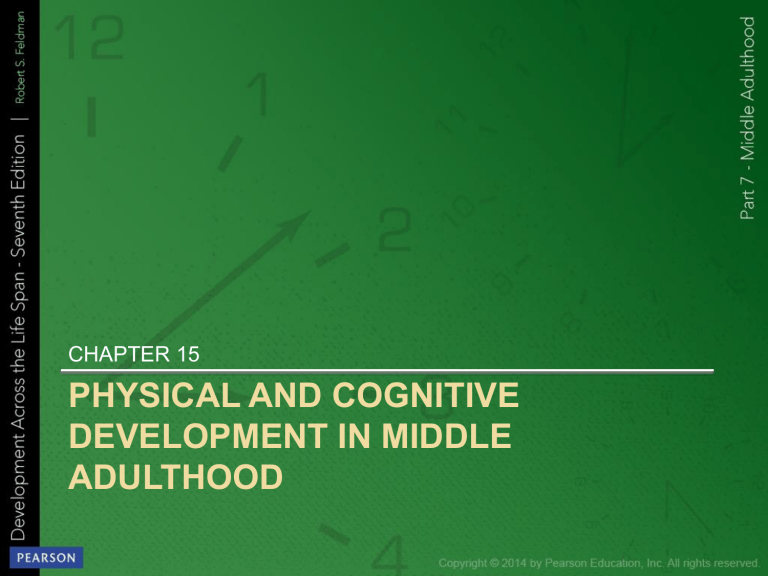
CHAPTER 15
PHYSICAL AND COGNITIVE
DEVELOPMENT IN MIDDLE
ADULTHOOD
Learning Objectives
PHYSICAL DEVELOPMENT
Age Changes
• What stays the same as we age?
• What changes with age?
Physical Transitions in Middle Adulthood
• Gradual psychological and emotional changes in body's capabilities
• Depends in part on self-concept and lifestyle
There was an old lady….
Society applies a double standard to men and women in terms of appearance
• Older women tend to be viewed in unflattering terms
• Aging men more frequently perceived as displaying a maturity that enhances status
Height, Weight, and Strength: Benchmarks of
Change
• After age 55, bones become less dense
– Ultimately women lose 2 inches and men lose 1 inch in height
• Women are more prone to declining height due to osteoporosis
• Both men and women continue to gain weight in middle adulthood
Sights and Sounds of Middle Age
• Starting at age 40, visual acuity declines
– Changing eye's lenses in shape and elasticity results in loss of near vision, called presbyopia
– Glaucoma
Do you hear what I hear?
PRESBYCUSIS
– About 12 percent of people between 45 and 65 suffer from presbycusis
– Men more prone to hearing loss
– Sound localization is diminished
Reaction time:
Not-so-slowing Down
• Decreases slightly in middle adulthood
• Improves or compensated for by being more careful and practicing the skill
• Lifestyle choices like exercise can slow this loss
“ Use It or Lose It ”
Sex in Middle Adulthood: The Ongoing
Sexuality of Middle Age
Sexuality remains an important part of life for most middle-aged people
• Frequency of sexual intercourse decreases with age
– Sexual activities remain a vital part of most middleaged adults ’ lives
– Adults have more freedom
– Women no longer need to practice birth control
Sexual Intercourse
Both men and women can face some challenges to their sexuality during middle adulthood
• Men typically need more time to get an erection
– Volume of fluid in ejaculation declines
– Production of testosterone also declines
• In women, walls of the vagina become less elastic and thinner
– Vagina shrinks, potentially making intercourse painful
Frequency of Sexual Intercourse
Female Climateric
• Starting about age 45, transition from being able to bear children to being unable to do so
• Lasting about 15 to 20 years
• Menopause
Menopause
Estrogen replacement therapy (ERT)
• Women's expectations about menopause relate to their experience of menopause
– Variations by race and culture
The Dilemma of Hormone Therapy
Estrogen and progesterone used to alleviate menopausal symptoms: Early findings
PRO
• Changes ratio of “good” cholesterol to “bad” cholesterol
• Decreases thinning of bones
• Associated with reduced risks of stroke and colon cancer
• Cognitive advantages
• Enhances sex drive
CON
• Increases risk of breast cancer and blood clots
• Higher risk for pulmonary embolism and heart disease
And So…
• Results of the Women's Health Initiative study led to a profound rethinking of the benefits of HT
– Questions if HT could protect postmenopausal
– women against chronic disease
• Many women stopped taking hormone replacement drugs
– 40 percent of postmenopausal women in the U.S. were using hormone therapy in 2002
– 20 percent a decade later
• Most recent thinking among medical experts is that it's not a simple all-or-nothing proposition
–
Some women are simply better candidates for HT than others
The Psychological Consequences of
Menopause
• Early research
– Menopause was linked directly to depression, anxiety, crying spells, lack of concentration, and irritability
• Current research
– Normal part of aging that does not, by itself, produce psychological symptoms
• Effects influenced by personal and cultural expectations of menopause
Do men experience the equivalent of menopause?
Male Climacteric
• Male changes during middle age
– Period of physical and psychological change relating to male reproductive system that occurs during late middle age.
– Enlargement of the prostate gland
– Problems with urination, including difficulty starting to urinate and frequent need to urinate during night
• Men still produce sperm and can father children through middle age
Review and Apply
REPLY
• People in middle adulthood experience gradual changes in physical ____ and ____.
• The acuity of the senses, particularly ____ and
____, and ____ ____ ____declines slightly during middle age.
• Sexuality in middle adulthood changes ____, but middle-aged couples, freed from concerns about children, can often progress to a new level of
____ and ____.
Review and Apply
REPLY
• Physiological changes relating to sexuality in
_____ and _____.
• Both the female climacteric, which includes
_____, and the male climacteric seem to have
_____ and perhaps _____ symptoms.
Review and Apply
APPLY
• Would you rather fly on an airplane with a middle-aged pilot or a young one? Why?
HEALTH
Complete the following sentences:
• Middle-aged people like to ____.
• Middle-aged people get annoyed by ____.
• Middle-aged people's health is ____.
• Middle-aged people's cognitive abilities are ____.
• The societal stereotype about middle age indicates____.
Worries of Adulthood
Chronic Diseases in Middle Adulthood
• Arthritis typically begins after age 40
• Diabetes is most likely to occur in people between the ages of 50 and 60
• Hypertension (high blood pressure) is one of the most frequent chronic disorders found in middle age
Chronic Diseases during Middle Adulthood
• Certain chronic diseases often begin to appear during middle adulthood
– Arthritis
– Obesity
– Hypertension
• See Table 15-1 for adult preventative health care screening recommendations
Adult Preventive Health-Care Screening
Recommendations
Adult Preventive Health-Care Screening
Recommendations
Adult Preventive Health-Care Screening
Recommendations
Gender Differences
• During middle age, women experience more non-life threatening illnesses than men but men experience more serious illnesses
– Women smoke less; drink less alcohol; have less dangerous jobs
• Medical research has typically studied diseases of men with all male samples; the medical community is only now beginning to study women's health issues
Individual Variation in Health: Ethnic and Gender
Differences
Variations
– African Americans death rate is twice rate for
Caucasians
– Lower family's income higher likelihood of disabling illness, more dangerous occupations, inferior health coverage
Disability and Income Level
What are the consequences of stress in middle adulthood?
Stress produces three major consequences: direct physiological effects, harmful behaviors, and indirect health related behaviors.
(Source: Adapted from Baum, 1994.)
Stress in Middle Adulthood
• Stress continues to have a significant impact on health in middle age
• According to psychoneuroimmunologists, who study the relationship between the brain, the immune system, and psychological factors, stress produces three main consequences
• Leads to unhealthy behaviors
True or False?
Heart and circulatory disease in middle age are responsible for more loss of work and disability days due to hospitalization than any other cause.
The A's B's of Coronary Heart Disease:
Linking Health and Personality
More men die in middle age of diseases of the heart and circulatory system than any other cause.
– Both genetic and experiential characteristics are involved
– Heart disease runs in families
– Men are more likely to suffer than women, and risks increase with age
– Women are less vulnerable, but not immuned
Risk Factors for Heart Disease
Figure 15-7 Death from Heart Disease
Worldwide
The risk of dying from cardiovascular disease differs significantly depending on the country in which one lives.
What cultural or environmental factors might help to explain this fact?
(Source: Lloyd-Jones et al., 2009.)
Type A Behavior Pattern
• Type A behavior:
– Competitiveness, impatience, and a tendency toward frustration and hostility, are more susceptible to heart disease
– Evidence is only correlational so cannot say Type A behavior causes heart disease
Type B Behavior Pattern
• Type B behavior:
– Non-competitiveness, patience, and a lack of aggression
– Evidence that Type B people have less than half the risk of coronary disease than Type A people have
Type D Behavior Pattern
Denollet
• D for “distressed”
• Insecurity, anxiety, and negative outlook related to risk for heart attack
The Threat of Cancer
• Cancer is associated with genetic and environmental risks
– Poor nutrition, smoking, alcohol use, exposure to sunlight, exposure to radiation, and particular occupational hazards
– Early treatment is related to higher survival rate
Cancer Treatment
Treatment
• Takes a variety of forms
– Radiation therapy involves the use of radiation to destroy a tumor
– Chemotherapy involves the controlled ingestion of toxic substances meant to poison the tumor
• Surgery may be used to remove the tumor
• Early diagnosis is crucial
Breast Cancer
• Mammography , a weak X-ray, is used to detect breast cancer
• Death rate lower for those who had a "fighting spirit" or those who denied they had the disease
• A positive psychological outlook may boost the body's immune system
Breast Cancer Incidence and Age
Figure 15-8 Age and the
Risk of Breast Cancer
Starting around the age of 30, the risk of breast cancer becomes increasingly likely, as these annual incidence figures show.
(Source: Based on data from the American Cancer
Society, 2003.)
Psychological Factors Relating to Cancer:
Mind Over Tumor?
Power of a “ fighting spirit ”
Review and Apply
REVIEW
• In general, middle adulthood is a period of
____ health, although susceptibility to chronic diseases, such as ____, ____, and
____ increases.
• ____ ____is a risk for middle-aged adults.
Both ____ and ____ factors contribute to heart disease, including the Type ____ behavior pattern.
Review and Apply
REVIEW
• The incidence of ____ begins to be significant in middle adulthood.
• Therapies such as ____ therapy, ____, and
____ can successfully treat cancer, and psychological factors, such as a ____ ____and a refusal to accept the ____ of cancer, can influence ____ ____.
Review and Apply
APPLY
• What social policies might be developed to lower the incidence of disabling illness among members of lower-socioeconomic groups?
COGNITIVE DEVELOPMENT
Does intelligence decline in middle adulthood?
Difficulties in Answering the Question
Older research
• Cross sectional studies
• Cohort effect
Newer research
• Longitudinal studies
• Practice effect and participant attrition
Cognitive Development
Cross-sectional studies
• Older subjects scored less well than younger subjects on traditional IQ tests
– Intelligence peaks at 18, stays steady until mid-20s, and declines till end of life
Longitudinal studies
• Different developmental patterns in intelligence
– Stable and even increasing IQ scores until mid-30s and some to mid-50s, then declined
Testing Effects
Testing effects
• Practice effect
• Attrition
• Physical performance portion
– Timed
– Reaction time slows with age
– Results may be due to physical changes not cognitive changes
Complicating the Issue Further: What about the Kinds of Intelligence?
• Fluid intelligence is the ability to deal with new problems and situations
• Crystallized intelligence is the store of information, skills, and strategies that people have acquired through education and prior experiences, and through their previous use of fluid intelligence
The Answer-Maybe
• When developmentalists looked at the two kinds of intelligence separately, a new answer appears to the question of whether intelligence declines with age
• There are two answers: yes and no
– Yes , because in general, fluid intelligence does decline with age
– No , because crystallized intelligence holds steady and in some cases actually improves
Changes in Crystalized and Fluid Intelligence
One More Explanation: Schaie (1994)
• Many particular types of ability, such as spatial orientation, numeric ability, and verbal ability, rather than the broad divisions of crystallized and fluid intelligence
• When considered this way
– Certain abilities, such as inductive reasoning, spatial orientation, perceptual speed, and verbal memory, begin to decline very gradually at around age 25 and continue to decline through old age
– Numeric ability tends to increase until the mid-forties, is lower at age 60, and then stays steady throughout the rest of life
– Verbal ability rises until about the start of middle adulthood, around age 40, and stays fairly steady throughout the rest of the life span
Continued Competence during Gradual
Decline: Why?
Salthouse suggests four reasons why this discrepancy exists:
Highly Successful Middle-Aged People
Who do you know?
The Development of Expertise: Separating
Experts from Novices
• Expertise is the acquisition of skill or knowledge in a particular area, develops as people devote attention and practice
– Expert = rely on experience and intuition, process information automatically, use different neural pathways to solve problems
– Novice = strictly follow formal rules and procedures, use better strategies and better problem-solving
What Is Multitasking Doing to Our Brains?
Multitaskers versus Non-multitaskers
• Multitaskers may be oversensitive to incoming information
(Ophir, Nass, & Wagner, 2009)
• Middle-aged adults with internet searching experience show higher levels of brain activation when searching than those reading pages of text
– Suggests development of new neural pathways involved in decision-making and reasoning
• People with considerable experience playing video games actually become better at reacting to stimuli, singling out important information, and switching between tasks
What IS Clear about Multitasking
• Certain kinds of tasks are inherently difficult to carry out simultaneously, such as driving and texting:
• A considerable body of research shows that it can't be done safely!
Memory: You Must Remember This
According to research on memory changes in adulthood
• Most people show only minimal losses
• Many exhibit no memory loss in middle adulthood
Memory is viewed in terms of three sequential components
• Sensory memory
• Short-term memory holds information for
15 to 25 seconds
• Long-term memory
Schemas in Middle Adulthood
Schemas
• Help people represent the way the world is organized
• Aid in categorization and interpretation of new information
• Convey cultural information
Effective Strategies for Remembering
Mnemonics
• Get organized
• Pay attention
• Use encoding specificity phenomenon
• Visualize
• Rehearse
Review and Apply
REVIEW
• The question of whether intelligence ____ in middle adulthood is complicated by limitations in ____ ____ studies and ____ studies.
• Intelligence appears to be divided into components, some of which ____while others hold steady or even ____.
Review and Apply
REVIEW
• In general, cognitive competence in middle adulthood holds ____ ____despite declines in some areas of ____ functioning.
• Memory may appear to ____ in middle age, but in fact ____ ____ memory deficits are probably due to ineffective strategies of ____ and ____.
Review and Apply
APPLY
• How might crystallized and fluid intelligence work together to help middle-aged people deal with novel situations and problems?
EPILOGUE
Return to the prologue of this chapter, about Milo Janus's changing priorities after his heart attack, and answer these questions .
• If you were Milo's physician, how would you explain the link between his personality and his heart disease?
• If his heart attack hadn't slowed Milo down in middle age, what else might have? Or would he have likely continued his driven lifestyle largely unimpeded as he got older?
EPILOGUE
• What developmental changes might Milo's wife be experiencing at this point in life? How might Milo's lifestyle change in midlife be affecting her?
• Whereas Milo's job relies heavily on his knowledge and problem solving abilities, how would you predict his performance might change over the next decade, if at all?

